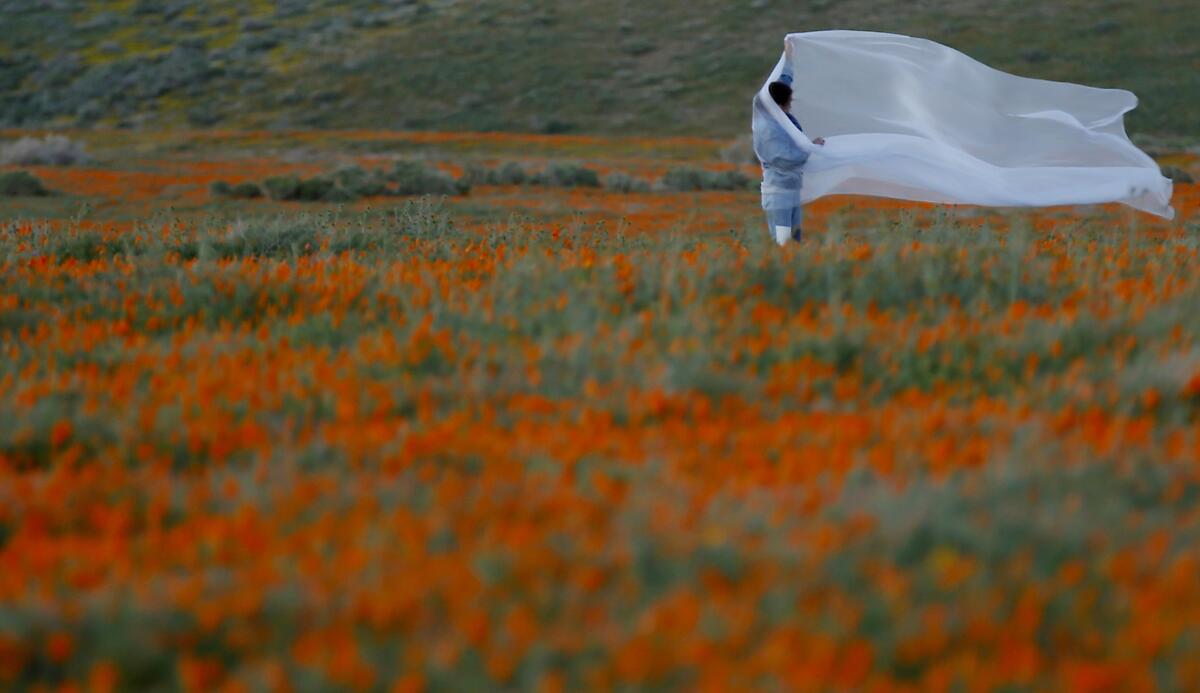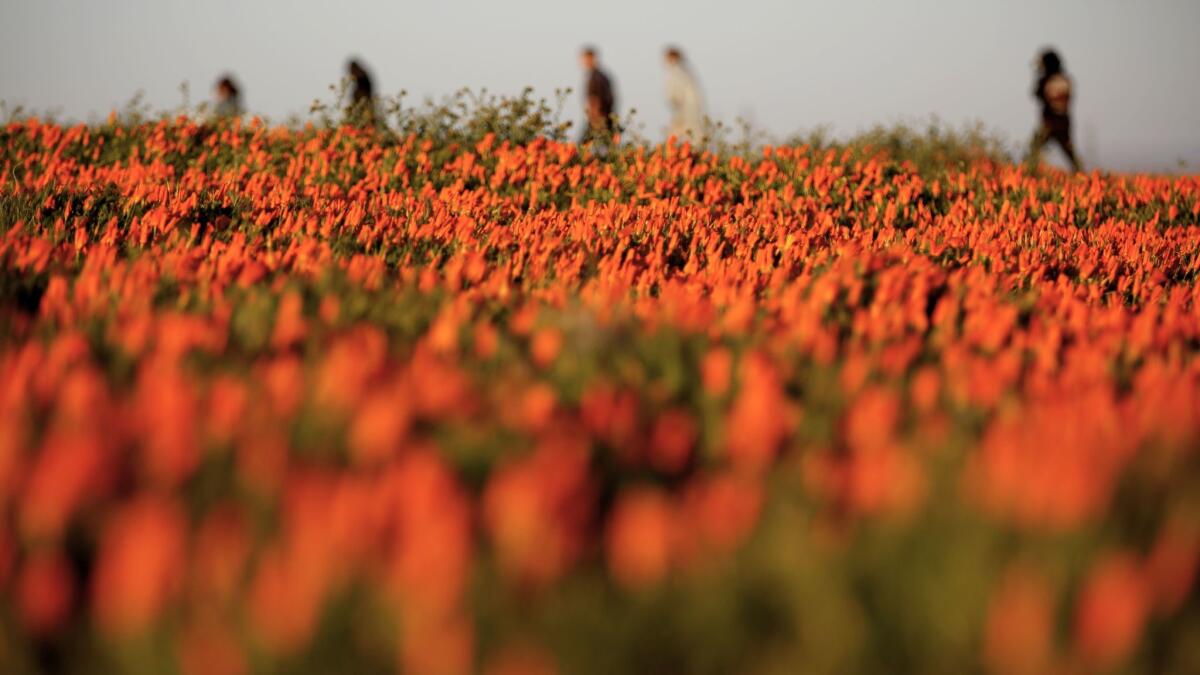California Journal: The Antelope Valley poppies have exploded into a spectacular burst of neon, signaling an end to drought

- Share via
Reporting from Lancaster, CALIF — They come upon you before you know it. You exit Highway 14 in the Antelope Valley and suddenly, as you drive west along Avenue I, they hit you with an unexpected force.
Brilliant orange fields of poppies blanket the hillsides. Acres and acres of poppies. Football fields of poppies. What is this, you think, the “Land of Oz”?
You cannot help but smile and let out a whoop.
For denizens of a drought-fatigued state accustomed to looking out car windows and seeing brown everything, the flaming poppies come as a shock.
But here is your inevitable conclusion: California is back. After years of drought, the state has come alive again. It is green and vibrant. Nowhere is the landscape more spectacular than here, where an electric patchwork of grasses and wildflowers is dominated by the neon bloom that has a claim on the heart of every Californian.
Right now, kajillions of the delicate flower enliven the western Antelope Valley. The best, and safest, place to see them is the Antelope Valley Poppy Reserve, an 1,800-acre state park 15 miles west of Lancaster.
It’s not just poppies that come out after bountiful rains. There are swaths of a dozen different wildflowers, including yellow goldfield flowers, shocks of magenta filarees and purple pygmy-leaved lupine.
“Those are blue dicks,” said Seth Wagerman, a volunteer guide at the reserve, pointing to some tiny violet flowers. “Or wild hyacinth if you’re leading a tour of young boys.”
Tuesday morning, I happened to arrive at the reserve just in time for an hour-long tour with Wagerman, 43, who was leading his first outing. In real life, he teaches psychology at Pepperdine University in Malibu two days a week. He was a natural.
“Interrupt me to ask me any questions,” he told our little group of 10. “I’ve been married 10 years and I’m used to it.”
::
If like me, you grew up in Southern California, your parents probably drilled you with forbidding information about certain plants.
For example, you do not, under any circumstances, eat oleander leaves or feed them to the pets.
During a Santa Ana wind, you risk death by standing near a palm tree (fronds) or a eucalyptus tree (shallow roots).
And if you pick a wild California poppy, you could end up in jail.
The first two are indisputable. As it turns out, however, the poppy is not specifically protected under state law. But California law makes it illegal to remove any plant material from state land or a county highway right-of-way without permission.
So basically, Mom and Dad were right.
Plucking a poppy from a state park or roadside is a misdemeanor, punishable by a $1,000 fine or six months in jail. (I tried, but could find no evidence that anyone has ever been jailed for illicit poppy picking.)
Also, you should probably be aware, you can do whatever you want with a poppy that grows on private property. You could, for instance, boil the flowers with lard, like the Spaniards used to do, in a vain effort to reverse baldness, a historical tidbit I picked up from Wagerman.
“They just ended up with greasy heads,” he said.
::
The Antelope Valley Poppy Reserve sits about 50 miles north of the San Fernando Valley, ringed by the Tehachapi Mountains to the north, and the snow-topped San Gabriels to the south.
If you visit this season, which lasts through May, try to go on a week day, as the large parking lot fills quickly on weekends. As it was, on Tuesday morning at 10:30, I waited about 20 minutes to get into the lot.
In the reserve, which has 8 miles of trails, visitors are expected to stay on the dirt paths. Venturing into the flowers is ecologically boorish and not wholly safe.
“We are very lucky to host the most toxic rattlesnake of all, the Mojave Green rattlesnake,” Wagerman said. “Usually when they bite, they are ‘dry bites,’ as they are saving up their venom for prey. But the babies release all their venom because they don’t know better.”
Their venom is full of hemotoxins and neurotoxins, he said. “They can clot up your blood like pudding.’”
I assume this threat was lost on the dozens of poppy seekers who eschewed the parking lot (and $10 entry fee) and instead parked along the shoulder of West Avenue I, just outside the reserve.
From the road, they could stroll unimpeded (except for snakes and gopher holes) right into an ankle-high forest of poppies. They could tippy-toe through them, sprawl on them, or pose with their dogs, which are not permitted in the reserve. I saw at least two models with camera crews. It’s not so dangerous to park here.
But that’s not the case about 30 miles west of here, along Interstate 5 in the Tejon Pass. On Sunday, the California Highway Patrol tweeted a plea to motorists: “Please do not stop on the side of the freeway to view the Poppies. It is extremely dangerous and not worth risking your life.”
You’d think people would know that. Then again, the sight of so many poppies can intoxicate.

Wagerman’s tour lasted about an hour. As we were climbing up an easy hill to Kitanemuk Vista Point, one of the highest places in the reserve, a middle-aged man passed us going downhill, talking to himself.
“Pictures don’t do this place justice,” he muttered. “It is just so beautiful.”
He’s right, I thought.
Out in the middle distance, poppies and grasses undulated in the breeze, rippling and alive.
Twitter: @AbcarianLAT
ALSO
You probably don’t see the dredge in Marina del Rey, but it’s going to make your summer better
Big Sur is once again coping with natural disaster and looming economic catastrophe







